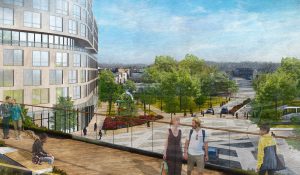Long viewed as a gritty industrial powerhouse that maintained its reputation as a Rust Belt disaster after the collapse of the steel industry in the early 1980s, Pittsburgh has become a beacon for post-industrial recovery in the twenty-first century. Praised by a Brookings Institution report of 2017 for its position “as a center of world-class research institutions, technology-intense manufacturing, and high-skill workers,” the city appeared to offer a model for second-tier cities seeking to compete in the global economy. Yet even as Brookings’s metropolitan policy director Bruce Katz announced the research center’s 2017 study under the title, “Why the Future Looks Like Pittsburgh,” critics noted the report’s admission that “despite its significant assets, Pittsburgh’s technological strengths have not yet translated into broad-based economic opportunity or growth.
At only 1.7 square miles, the Oakland neighborhood hosting Carnegie Mellon and Pittsburgh universities has outsize impact by being responsible for one-third of the entire state of Pennsylvania’s university research output. Now, the city hopes to make such concentrated opportunities more broadly inclusive. Noting the undesirable effects of deploying new technologies on inequality, employment, and gentrification, former mayor Bill Peduto, in partnership with the Heinz Endowments, formed P4: People, Planet, Place and Performance in 2015 with the announced goal for Pittsburgh “to become not just economically successful, but also inclusive and just.” That beginning has since been taken up in the city’s plan for Oakland which makes one of its priorities to “acknowledge and address inequities for Black residents, students of all backgrounds in Oakland, and create a welcoming environment for the neighborhood’s growing immigrant and newcomer community.”
A test of that commitment came recently in Walnut Capital’s “Oakland Crossings” proposal to redevelop 18 prime acres in Oakland using a zoning variance allowing buildings up to 180 feet in height. Area neighbors objected to the prospect of a glass canyon that would further marginalize

Oakland Crossings (Walnut Capital)
them from the work going on inside those buildings, and with the election of Peduto’s successor, Pittsburgh’s first Black mayor, Ed Gainey, the Pittsburgh Planning Commission embraced a lower height ceiling, offering additional bonuses for items such as energy efficiency, a commitment to hiring underrepresented groups for the operation of the building for the first 10 years, and for constructing a grocery store in the development. Most notably, the revised proposal utilized for the first time the city’s Housing Authority Choice Voucher Program to reach inclusionary zoning requirements that at least 10% of the housing units rents are affordable to households earning up to 50% of the area median income for a minimum of 35 years.
The decision won’t assure a connection between jobs and nearby residents, but a least it will recognize the importance of conforming with neighborhood input to the larger Oakland Plan, a concern expressed especially by the Oakland Planning and Development Corp, which objected to the original proposal, writing:
“It’s understood that market-rate rental is a money-maker here, and developers need no public subsidies or other incentives to build it. What Oakland needs is a set of tools to capture some of the value of that market rate development, to fund the construction of more affordable units. But the purpose of this bill is to offer incentives to private developers to build market-rate residential units (including subsidy from the University of Pittsburgh, and height bonuses in the bill for the construction of hotels and apartment buildings), and to allow those developers to avoid any requirement to include affordable housing units in their projects.”
Alteration of the original plan rightfully drew praise from the Post Gazette, which commented, “What began under former Mayor Bill Peduto as a textbook example of the aloof and heavy-handed use of power has concluded under Mayor Ed Gainey as a model of community engagement and professional negotiation.”